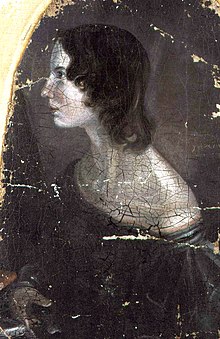Branwell Brontë
[3][4] He was born in a house (now known as the Brontë Birthplace) in Market Street, Thornton, near Bradford, West Riding of Yorkshire,[3] and moved with his family to Haworth when his father was appointed to the perpetual curacy in 1821.[3] He took a leadership role with Charlotte in a series of fantasy role-playing games which the siblings wrote and performed about the "Young Men", characters based on a set of wooden soldiers.[3] Branwell's particular interest in these paracosms were their politics and wars, including the destructive rivalry between their heroes, Charlotte's Arthur Wellesley, Duke of Zamorna, and his Alexander Percy, Earl of Northangerland.He documented in encyclopaedic detail, in neat lists, footnotes, sketches, and maps, the geography, history, government, and social structure of the Glass Town Federation (and later, the new kingdom of Angria)—laying down the parameters of the imaginary world".[3] During this time he wrote letters to his pub friends in Haworth which give "a vivid picture of Branwell's scabrous humour, his boastfulness, and his need to be accepted in a man's world".[4][6] During this employment he continued his literary work, including sending poems and translations to Thomas De Quincey and Hartley Coleridge who both lived in the Lake District.His complexion was fair and his features handsome; his mouth and chin were well-shaped; his nose was prominent and of the Roman type; his eyes sparkled and danced with delight, and his forehead made up of a face of oval form which gave an irresistible charm to its possessor, and attracted the admiration of those who knew him."[4] During his 30 months service Branwell corresponded with several old friends about his increasing infatuation with Robinson's wife Lydia, née Gisborne, a charming and sophisticated woman, almost fifteen years senior to him.[4] According to Gaskell, he received a letter "sternly dismissing him, intimating that his proceedings were discovered, characterising them as bad beyond expression and charging him, on pain of exposure, to break off immediately, and for ever, all communication with every member of the family.[4] Brontë returned home to his family at the Haworth parsonage, where he looked for another job, wrote poetry and attempted to adapt Angrian material into a book called And the Weary are at Rest.[15] On 24 September 1848, Brontë died at Haworth parsonage, most likely due to tuberculosis aggravated by delirium tremens, alcoholism, and laudanum and opium addiction, despite the fact that his death certificate notes "chronic bronchitis-marasmus" as the cause.[3] Elizabeth Gaskell's biography of Charlotte reports an eye-witness account that Brontë, wanting to show the power of the human will, decided to die standing up, "and when the last agony began, he insisted on assuming the position just mentioned.[18] British novelist Robert Edric wrote Sanctuary (2014), a novel chronicling Branwell's final months, during which family secrets are revealed and he learns about the publication of his sisters' books.In Tim Powers' novel My Brother’s Keeper (2023), Branwell is a major character, along with his sister Emily as the protagonist, as well as, to a lesser extent, the rest of the Brontë family.



Thornton, West Riding of YorkshireHaworthWest Riding of YorkshirePatrick BrontëMaria BranwellBrontë familyCharlottetranslationsGlass TownMaria Branwell BrontëBrontë BirthplaceThorntonBradfordCowan BridgeElizabeth GaskellCharlotte BrontëNoctes AmbrosianaeBlackwood's MagazineparacosmsUniversity of New South WalesJames HoggMasonic LodgeJohn BradleyKeighleyRoyal Academy of ArtsHalifaxBroughton-in-FurnessKendalThomas De QuinceyHartley ColeridgeLake DistrictHoraceJuliet BarkerJoseph Bentley LeylandManchester and Leeds RailwaySowerby Bridge railway stationLuddendenfoot railway stationLittle OuseburninfatuationHaworth parsonagealcoholismopiatestuberculosisdelirium tremenslaudanumaddictionbronchitismarasmusScarboroughPolly TealeBrontëBlake MorrisonChekhovThree SistersRobert EdricStella GibbonsCold Comfort FarmTim PowersDevotionArthur KennedyThe Brontë SistersPascal GreggoryAdam NagaitisTo Walk InvisibleFionn WhiteheadThe Glass TownThe Young Men's Magazine, Number 1 – 3Barnard, RobertMarshall, JohnDavid & CharlesVarietyWinifred GérinDaphne du MaurierLibriVoxNew York Public LibraryBrontë sistersJane EyreShirleyVilletteThe ProfessorTo a Wreath of SnowF. De Samara to A. G. A.Come hither childA Death-SceneWuthering HeightsLines Composed in a Wood on a Windy DayAgnes GreyThe Tenant of Wildfell HallPoems by Currer, Ellis, and Acton BellList of Brontë poemsJuveniliaA Book of RyhmesThe Young Men's MagazineGondalFamilyMaria BrontëElizabeth BrontëElizabeth BranwellArthur Bell NichollsJohn KingstonWilliam MorganvillageHartsheadBrontë CountryBrontë Parsonage MuseummuseumBrontë WaterfallBrontë WayCowan Bridge SchoolSt Michael and All Angels' ChurchchurchpastorEllen NusseybiographerMary TaylorConstantin HégerteacherGeorge SmithpublisherDevotion (1946 film)Les Sœurs Brontë (1979 film)Brontë (2005 play)To Walk Invisible (2016 film)Emily (2022 film)Victorian literature